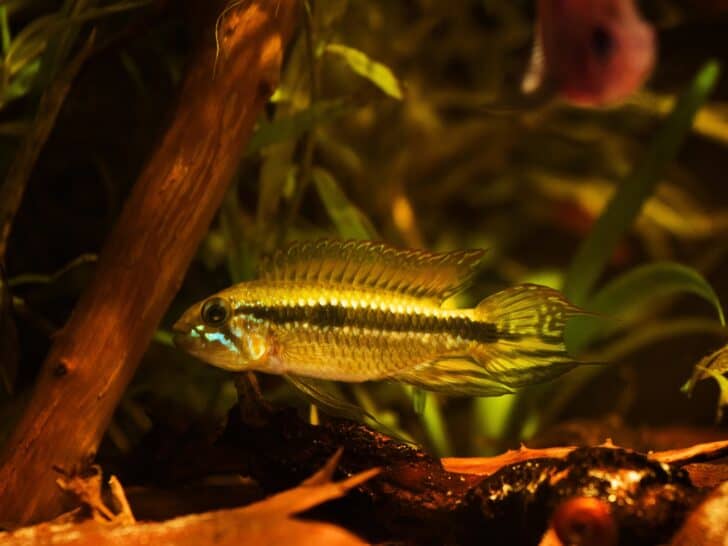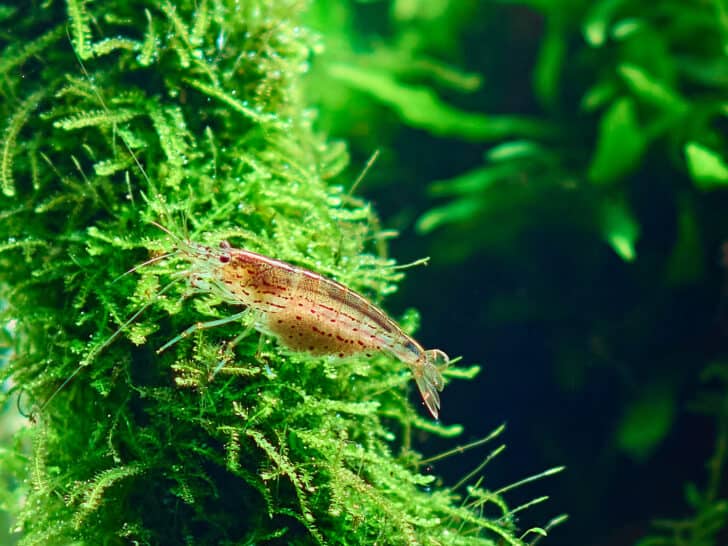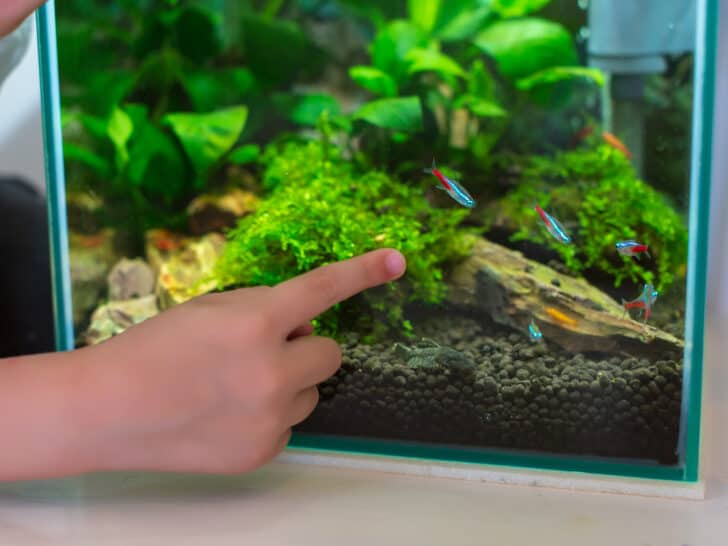You want your aquarium to resemble a natural aquatic environment. You create an aquascape with reefs, gravels, and plants, but much to your chagrin, the plants don’t stay where you want them to be. Trying to keep them in place with weights or strings is such a bother.
Quick Answer
You can safely use super glue for aquarium plants because its active ingredient, cyanoacrylate, is not toxic to aquatic life. According to a paper published in Anaesthesia and Intensive Care, cyanoacrylate is safely used in human medical settings to close wounds and secure intravascular catheters.
In this article, I’ll explain why super glue is safe for use in the aquarium and how you can use it to secure your aquatic decorations. I’ll also do a deep dive (excuse the pun) into the advantages of super glue over other kinds of adhesives and explain how you can make your tube of glue last long.
Super Glue Safety for Aquarium Plants
Super glue is safe for aquatic life because of its unique ingredient, cyanoacrylate. Read on to learn more about this ingredient and why it’s safe for aquatic plants and fish.
Is Cyanoacrylate the Same as Super Glue?
Cyanoacrylate isn’t the same as super glue. It’s the technical term for instant and strong-bonding adhesives used in industrial, healthcare, and household settings. Super glue is any powerful quick-bonding adhesive containing cyanoacrylate.
I recommend the Starbond EM-02 Super Glue. It’s a high performance glue that’s great for a variety of hobbies and has a long shelf life.
Sometimes a particular brand of super glue can have ethyl cyanoacrylate listed as its active ingredient. It’s just a different chemical composition of cyanoacrylate. The glue is just as effective and safe as an adhesive with cyanoacrylate.
How Do I Use Super Glue for Aquarium Plants?
There was once a time when I often woke up in the mornings to find my aquarium plants dislodged from where I had fixed them the evening before and floating in the water. You’re probably familiar with the feelings of exasperation I experienced then.
Here’s how you can use super glue to fix aquarium plants to live rocks:
- Take the rock out of the aquarium. Cyanoacrylate, the active component of super glue, dries very fast when it comes in contact with water. I wouldn’t recommend trying to fix your decorations underwater. You may be lightning fast, but you’ll still end up wasting a lot of glue. Instead, take the rock you want to fix your plant to out of the aquarium.
- Dry the rock thoroughly. Remove any slime that may be sticking to its surface. Drying ensures the largest surface area is available for the glue to create stable and lasting bonds.
- Dry the roots of the plant. Use a paper towel to dab the roots of the plant gently. Avoid squeezing or twisting the roots; otherwise, you’ll damage them.
- Apply glue on the rock and the plant. Make sure your hands are dry. Apply a thin but uniform coat of glue on the rock and the roots of the plant. Carry out this step quickly because super glue dries very fast. Don’t slather on the glue over the tiny roots or delicate rhizome of your sapling.
- Press the plant roots to the glue on the rock. I recommend using cotton swabs or popsicle sticks during this process to avoid getting glue on your fingers.
- Press the plant gently to the rock for 7-10 minutes. Pressing secures the plant and also helps cure the glue.
- Sprinkle sand over the glued surface. Super glue appears as a white deposit near the bond line when it dries and thus shows up prominently on the rock. Sprinkling sand hides the joint where the plant has been fixed to the rock and makes the arrangement look natural.
- Gently place your decoration inside the tank. I think it’s a good idea to put gravel on top of the rock to secure the arrangement. You can remove the gravel after a couple of hours.
If you’re looking for some inspiration of aquatic plants that you can fixate to wood or rocks, make sure to check out this list! It contains some beautiful plants.
You can also follow the steps above to fix plants to live rocks and corals. The plants, the rock, and the coral will grow over the joint and hide all traces of the glue.
Super glue also works with:
- Wood
- Stone
- Metals
You can use it to fix plants to decorations like castles.
You can use super glue to fix two rocks. If you can’t remove one stone from the aquarium:
- Take the other rock out.
- Clean and dry it thoroughly before applying glue.
- Place it inside the aquarium and quickly (and I cannot stress this enough) fix it on the other rock.
- Keep pressing the two rocks together for some time.
Here’s a video on YouTube by Girl Talks Fish that demonstrates how you can use super glue to create stunning aquascapes with live plants:
What Are the Advantages of Using Super Glue in the Aquarium?
Super glue provides several benefits for use in aquariums as follows:
- It’s safe for marine life. Super glues that contain cyanoacrylate as their only active ingredient are safe for marine life. They’re non-toxic to fish, don’t harm plants and their roots, and allow live rocks to grow.
- It works for many different substrates. Super glue works on many types of porous and non-porous materials, such as wood, stone, rock, metal, glass, ceramic, and steel. You can use it for almost any kind of decoration you choose for your aquarium.
- It is convenient to use. Unlike many other adhesives, super glue doesn’t need to be mixed with other substances in complex ratios for it to work. You don’t have to apply heat or ensure the ambient temperature is at a specific degree. You need a little bit of moisture to cure super glue and form a strong bond.
- It has a quick cure time. After applying super glue on the surface of the object you want to join with another, press the objects together and wait for a few minutes. The glue cures in 10 minutes and lets you move on to your next project.
- It has high bond strength. The bond strength of super glue compares favorably with other adhesives like epoxies and polyurethane products. Super glue eases my life and saves my time and effort because the aquarium decorations remain in place for a long time.
- It’s water-resistant. Super glue doesn’t lose its bond strength when it’s in contact with fresh or salty water. Being water-resistant ensures your decorations remain in place for a long time.
- It remains stable even at high temperatures. Super glue can withstand high temperatures without losing bond strength or developing gaps. You can keep the water temperature inside the aquarium at a level that’s comfortable for the fish without worrying about the glue peeling off.
- It’s cheap and readily available. Super glue has many uses across diverse industries and healthcare settings. That’s why it’s found in most stores, not just specialty fish shops. The product is also cheap, and you can carry out your aquascape projects to your heart’s content.
- It is easy to remove. If you are like me, you probably play around with your aquarium decorations often. The arrangement with reefs and plants starts to look unexciting. Or you may want to add a few LEGO blocks to a decoration. What I like most about super glue is how easy it is to remove. Although it cures quickly, stable bonds, you can easily remove it using a nail polish remover or other acetone-based solutions.
- It’s an eco-friendly product. Super glues don’t contain environmentally-harmful solvents. You can now indulge in your hobby without feeling pangs of guilt.
How Can You Use Super Glue Safely and Effectively?
With so many advantages, you may be tempted to use super glue for every aquarium project you dream up. While it is convenient for aquarium decoration projects, you need to keep the following tips in mind to ensure safe and effective usage:
- Regular super glue works best on porous surfaces.
- If you want to use super glue on non-porous materials like glass or steel, mist the surface lightly before spreading the glue.
- It works best when you use it in small areas. Given its composition, super glue can’t form strong bonds when applied to large areas. The adhesive may also not cure fully if it’s applied over a large area. This results in weak bonds with microscopic gaps.
- More isn’t always better! Don’t apply excessive amounts of glue on the bonding surface. Besides wasting the material, the excess glue might not cure fully or create an unsightly white appearance on the binding surface.
- Super glues come in liquid or gel versions. I recommend using the gel version because the liquid is runny and tends to get messy. The gel version has a higher viscosity, so there’s less dripping when you use it. I often use the Gorilla Super Glue Gel from Amazon.com.
- Don’t use super glue as a sealant for your aquarium. It tends to develop microscopic gaps after it dries and may lead to water leakage.
How Long Is the Shelf Life of Super Glue?
The shelf life of your tube or bottle of super glue is a maximum of 12 months if you don’t open the package. Once opened, it’ll last for about 4 to 8 weeks before turning into a hard lump that you can’t use. Moisture in the environment dries the glue and cures it.
How Can I Extend the Shelf Life of Super Glue?
Super glue dries quickly and is cured in the presence of moisture. You have to make sure that you keep your supplies in a dry place. Here’s how you can extend the shelf life of super glue:
- Refrigerate unopened bottles and tubes. Super glue’s physical and chemical properties aren’t altered or destroyed when unopened bottles and tubes are refrigerated.
- Store opened containers at room temperature. Don’t refrigerate opened glue containers. When moisture inside the refrigerator condenses, the droplets come into contact with the contents of the containers and cure the glue. Keep opened containers at room temperature. A temperature range of around 10-21 degrees Celsius (50-70 degrees Fahrenheit) is ideal.
- Ensure opened containers are air-tight. Keep opened glue containers tightly capped. Make sure the nozzle is clean and dry, so moisture and dirt don’t seep inside the container. Additionally, you can place the bottle or tube in an outer container with silica gel that will absorb moisture and extend the shelf life of the glue.
Final Words: Use Super Glue in Your Aquarium and Be Creative
Master how to use super glue safely for aquarium plants and other decorations. It takes just a little practice and plenty of attention while you’re creating the décor piece. But the rewards are immense.
The versatility, bond strength, and ease of use of super glue let you experiment with any arrangement your inner artist wants to create. The adhesive is cheap and affordable and can be removed easily. You can create a decoration with plants, corals, and rocks, and if you don’t like it, you can easily dismantle it and move on to your next vision.



